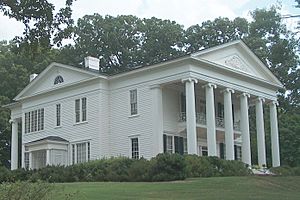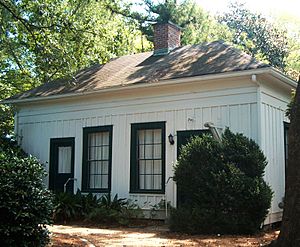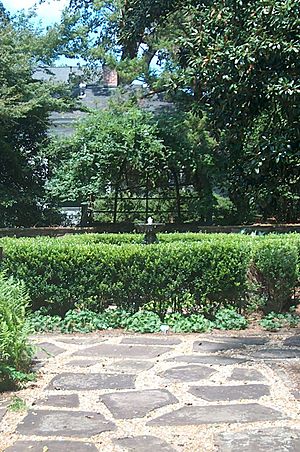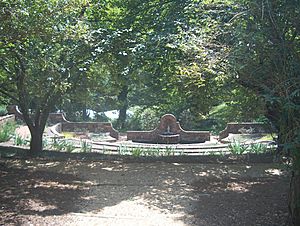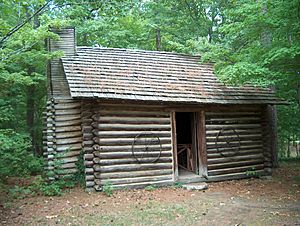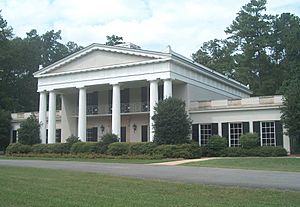- This page was last modified on 17 October 2025, at 10:18. Suggest an edit.
Oak Hill & The Martha Berry Museum facts for kids
| Oak Hill | |
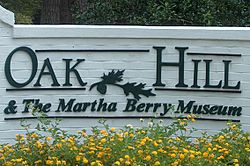
Gate Entrance to Berry Museum.
|
|
| Lua error in Module:Location_map at line 420: attempt to index field 'wikibase' (a nil value). | |
| Established | 1884 (original farmhouse in 1847) |
|---|---|
| Location | 24 Veterans Memorial Hwy Rome, Georgia, United States |
Welcome to Oak Hill & The Martha Berry Museum! This special place in Rome, Georgia, United States, is the former home of Martha Berry, who founded Berry College. It's now a museum where you can learn all about her life and the history of the college. Oak Hill is also a beautiful garden recognized as an All-America Selections Display Garden and is part of the historic Berry Schools listed on the National Register of Historic Places.
Contents
Exploring Oak Hill's History
Oak Hill is a large estate, about 170-acre (0.69 km2), featuring a grand Greek Revival style house. The original house was a Victorian-style farmhouse built in 1847. During the American Civil War, Union soldiers used the estate as a place to stay when they captured Rome.
How the Berry Family Came to Oak Hill
A writer named Charles H. Smith first owned the estate. He later sold it to Andrew M. Sloan. In 1868, Thomas Berry and his family moved to Rome, Georgia, from Alabama. Thomas became a partner in a successful business that sold groceries and cotton.
Around 1871, Thomas Berry bought the estate from Sloan for $9,000. He moved into the farmhouse with his wife, Frances Margaret Rhea, their eight children, and three orphaned children of his late brother. In 1884, after the farmhouse burned down, Thomas rebuilt it. He restored it as the Greek Revival style home we see today, naming it Oak Hill.
Martha Berry Takes Over Oak Hill
Thomas Berry's will stated that his home and 160-acre (0.65 km2) estate should be sold after his and his wife's deaths. The money was to be divided among his children. However, Martha Berry really wanted to keep the house. She saw it as her home, a place for her schools, and a symbol of her life's work.
In October 1927, her family sold their shares of the Oak Hill estate to Martha. She then gave the estate to The Berry Schools for five dollars. This meant Oak Hill would forever be part of her educational mission.
Making Oak Hill Modern
Once Oak Hill belonged to The Berry Schools, Martha decided to make some big improvements. She hired a famous architectural firm from Boston, Coolidge & Carlson. This firm had also designed other buildings on the Berry College campus.
Between 1927 and 1928, the inside of the house was completely redone. Old walls were replaced with new plaster. New features included electricity and indoor plumbing. Six and a half bathrooms were added, replacing the old outhouse. A steam heating system was also installed, as the house was very hard to heat with just fireplaces.
The renovations also brought a "new" parlor, kitchen, pantry, and library. An elevator was added in the 1930s. Two new bedrooms and a portico (a covered entrance) were built at the back of the house.
Special Rooms in Oak Hill
The dining room and parlor were combined into one large room, becoming a social center. It featured a bay window and a beautiful Chinese Chippendale mirror. The dining room was moved to where the master bedroom used to be. Its wallpaper, called Isola Bella, was very popular in the 1920s. The colonial-style furniture in the dining room was made by Berry students.
The kitchen was updated with all the latest features from the 1920s. This included a modern refrigerator, plenty of food storage, a bell system for calling staff, a stove, and cabinets.
The library, added in 1928, was one of Martha's favorite rooms. It had beautiful pecan wood paneling. In the 1930s, an elevator was installed for Martha. This was because she had a heart condition that made climbing stairs difficult. The elevator went from the first floor to her dressing room on the second floor. Her new bedroom and dressing room were designed with simple wicker furniture made by Berry students.
Original Family Rooms
Some parts of Oak Hill were not renovated. These rooms were used by the Berry family and students. They belonged to Martha's mother, Frances Rhea Berry; her niece, Virginia Campbell Courts; and her sister, Bessie Wright, and her husband, Judge Moses Wright. They all lived with Martha until they passed away. Another room was used by female Berry students who worked for Martha to gain work skills.
Oak Hill Opens as a Museum
In October 1972, Oak Hill opened to the public as a museum. This celebrated Martha Berry's 106th birthday. The museum included Oak Hill's outbuildings, the Berry Gardens, the bridal walk, the original cabin, and the Martha Berry Museum. The Oak Hill Gift Shop opened 24 years later.
The estate has also been a filming location for movies like Sweet Home Alabama, Perfect Harmony, and Remember the Titans.
Martha Freeman's Cottage
This small cottage was once a schoolhouse. It belonged to Martha Freeman, who was a servant and a very important family friend to Martha Berry. Martha Freeman was a former slave and married to Enoch Freeman, the Berry family's carriage driver. She helped raise the Berry children and was like a houseparent to them.
After her husband died in the 1890s, Martha Freeman moved into this cottage. She continued to help Martha Berry, the Berry students, and the creation of the Berry Schools. After Martha Berry passed away in 1942, Martha Freeman stayed on as the caretaker of the estate until she died in 1951. She was buried next to Martha Berry. Today, the cottage shows how Martha Freeman lived her life.
The Carriage House and Vintage Vehicles
The estate's reconstructed carriage house displays the old vehicles Martha Berry used until her death in 1942. Martha rode in these carriages and cars, but she never drove them herself. Male student drivers and Geddins Cannon, the grounds director, drove her everywhere.
Inside the carriage house, you can see a Berry buggy, a 1914 Ford touring car, a 1917 Ford Model-T, a 1940 Mercury, and a Fordson tractor. The 1940 Mercury was the last car Martha rode in before she passed away.
Beautiful Oak Hill Gardens
On the right side of Oak Hill, you'll find several beautiful gardens: the Formal Garden, Goldfish Garden, Sundial Garden, and Sunken Garden. A landscape artist from Philadelphia, Robert Cridland, designed these gardens in 1927. His designs matched the popular Colonial architecture style of the time.
Types of Gardens at Oak Hill
The Formal Garden, once Frances Rhea Berry's garden, features boxwood plants arranged in patterns with spraying fountains. This garden changes with the seasons, showcasing different flowers and plants throughout the year.
Across from the Formal Garden is the Goldfish Garden. This was Martha Berry's favorite spot. She would write letters under the arbor (a shaded walkway) here. Martha Freeman also used to feed the goldfish in the pond. Today, this garden displays herbs arranged in a knot garden around the pond.
Next to the Goldfish Garden is the Sundial Garden, which has a real sundial in its center. It is believed this garden was used for tea parties and growing roses. Like the other gardens, it changes with the seasons, featuring sunflowers in summer and mums in fall.
The last garden in the row is the Sunken Garden. Built between 1934 and 1936, it was originally an amphitheater for small concerts. Now, it's a lovely garden with Kwansan cherry trees (gifts from the Emperor of Japan in the 1930s) and a collection of day lilies.
The Bridal Walk
Near the carriage house, you'll find the Bridal Walk, with a small "chapel" building beside it. In the early 1900s, Martha Berry invited Berry newlyweds to walk down this path to a summerhouse at the end. There, they would make their first wish as a married couple. While weddings weren't common at Oak Hill itself, Martha encouraged students and alumni to use the chapels on the Berry College campus. The walk is lined with boxwoods, roses, and other flowering plants.
The Original Cabin: Birthplace of Berry College
The original cabin was built shortly after the American Civil War. It served as a playhouse for Martha Berry and her siblings and cousins when they were children. In the late 1890s, three young boys from Lavender Mountain came to this cabin. Martha taught them Sunday School lessons because they were uneducated and had never heard the Bible.
As word spread about her teaching and kindness, more people came to her for education. When the cabin became too crowded, the Possum Trot day school was started on the Berry campus to continue their learning. Possum Trot day school eventually grew into the Berry Schools, which is now Berry College. The cabin was once Martha's office before a new one was built on campus. Today, the cabin is a preserved site near the Martha Berry Museum, known as The Birthplace of Berry College.
Martha Berry Museum and Gift Shop
The Martha Berry Museum was built as a small part of Oak Hill in 1972 and opened in October. It was designed by architect Samuel Inman Cooper from Atlanta. The museum displays paintings of famous people like Henry Ford and Theodore Roosevelt in the lobby. There's a permanent exhibit that tells the story of the Berry Family and how the Berry Schools grew into Berry College. Temporary exhibits are also featured on the first floor.
The second floor showcases the art collection of Martha Berry's sister, Eugenia, and her husband, Prince Enrico of Italy. This collection includes paintings by both Italian and American artists, covering nearly 1000 years of art history.
The Oak Hill Gift Shop
The small gray cottage, built in 1846, was bought by the Berry family in 1928. It first served as the Oak Hill gatehouse, marking the main entrance. It was also the home of Martha's brother, Isaac "Ike." In 1995, it was moved behind the Martha Berry Museum to its current spot. The cottage was restored and enlarged, opening in 1996 as the Oak Hill Gift Shop. It features a lovely garden used for teaching landscaping techniques and displaying new plant selections.
See also
- Berry College
- Martha Berry
- History of Rome, Georgia

